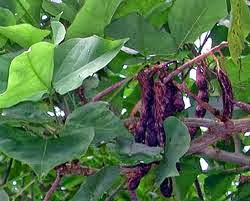Scientific name- Erythrina variegata
English name-Coral tree
Tamil name-mullumurukku
Sanskirt name-paribhadra-
Erabadu is a large quickly grown tree, with a smooth
yellowish gray bark. The leaves are tricate and bright green in colour. The
brilliant scarlet flowers are produced when the branches are bare of leaves
hence the name coral tree. Its medicinal purposes are fuund to be many. The
bark is a remedy against biliousness, and is useful in eye diseases. The inner
part of the bark ,coated with ghee,and held over a flam, forms affine soot,
used for watery eyes.
The juice of the leaf is injected into the ear, and it gives relief in cases of ear ache. The fresh juice of the leaves, with a little bees honey is an efficacious remedy for tape worm, threadworm, and round worm.
The juice of the leaf is injected into the ear, and it gives relief in cases of ear ache. The fresh juice of the leaves, with a little bees honey is an efficacious remedy for tape worm, threadworm, and round worm.
The tender leaves are cooked with coconut milk as a
vegetable for children who are one year old. This prevents worm complaints.
As an agent that promotes secretion and flow of milk, either the juice of the fresh leaves cook in coconut milk can be given to mothers during the period of lactation. The juice of the leaves is applied to the guns to relieve tooth ache.
A poultice of the leaves can be used over rheumatic joints. Indigenous physicians use to treat fractures and cattle diseases. It is used as an ingredient in many decoctions.
As an agent that promotes secretion and flow of milk, either the juice of the fresh leaves cook in coconut milk can be given to mothers during the period of lactation. The juice of the leaves is applied to the guns to relieve tooth ache.
A poultice of the leaves can be used over rheumatic joints. Indigenous physicians use to treat fractures and cattle diseases. It is used as an ingredient in many decoctions.










